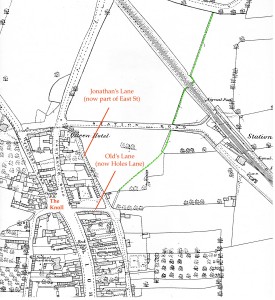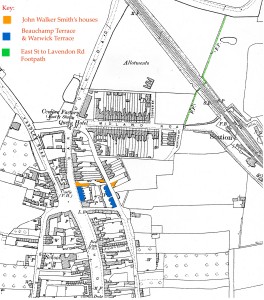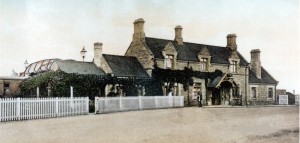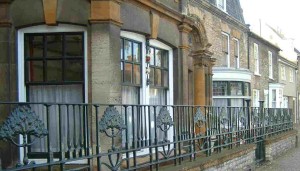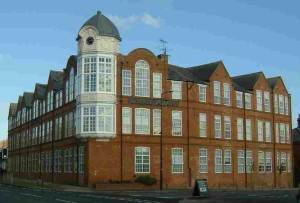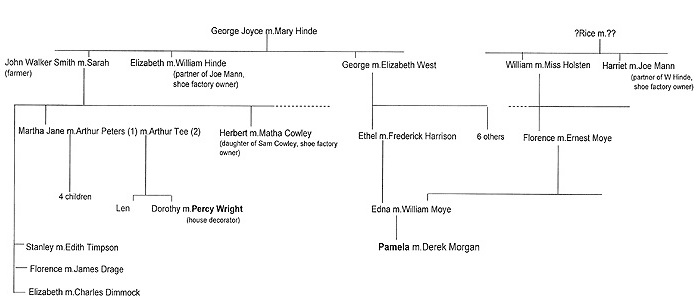Introduction
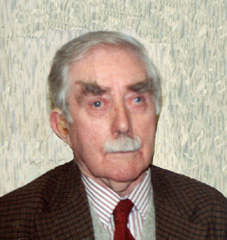
Percy Wright – 1989
Percy Wright lived in Olney for the whole of his 89 years. He was born in Yew Tree Cottage at the top of Weston Hill on 4th October 1908. He was a ‘house decorator’ by trade and married Dorothy Tee in 1932. In his later years he was a great correspondent. In addition to writing his memoirs, he wrote several letters to his friends around the town reminding them of earlier times and events in the town. This article comprises three of those letters, that is, a letter each to Pamela Morgan, Les Fairey and Brian Marshall. The letters have been edited by the Olney & District Historical Society for clarity. In the main we believe that they are quite informative and some of Percy’s anecdotal tales are very amusing.
The Olney & District Historical Society would be interested to learn if any other such letters are in existence.
First letter – A letter to Pamela Morgan
In this letter to Pamela Morgan, written on 23rd April 1997, Percy relates some tales of his wife’s family and her family ties with Pamela. For the sake of clarity, some of the information concerning Percy’s wife, Dorothy, has been transferred from the letter to Les Fairey to this one.
Dear Pam
When you rang me the other day, you mentioned the old times when I used to sing in the Congregational Church choir. Did you know before this, I was a choir boy in Olney Parish Church? They had no Sunday school there and one day Bill Wethers said “Did you know when they mixed the boys with the girls at school, the girl who sat next to you comes to our Sunday school, so would you like to leave the Church choir and come to Chapel with me? I will ask the Reverend Webb, and you will be able to see her” – so I left the Church to do a little bit of ‘young courting’. Soon she was invited to sing in the Chapel choir, neither Bill or me expected this, and later we were both very pleased to join the choir – and this is how me and Dorothy Tee ‘palled up’ together.
We had been engaged for over two years when I said I wanted to get married, but where? I suggested at the Church and Dorothy said “If it is your wish, to Church we will go”.
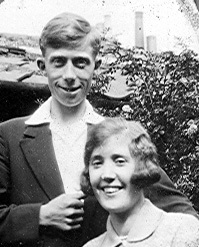
Percy & Dorothy – 1932
Reverend Evans was not pleased with us, and said so in one of his sermons, but I said “It is our lives and we are going to live together”. So we talked to the Reverend Gee and he said “23rd April is St George’s Day and we will settle on that day”.
Mrs Wilford, a friend of my parents, was pleased I was going back to the Church. She lived at 104 High Street, next door to Dr Dickenson, and had a cottage coming empty next door to Mrs Brundle in Weston Road. She asked us if we would like to have it; so this was our first home together. One Sunday, Reverend Collins came and spoke to us in Church and asked Dorothy if she would mind sitting alone as he would be pleased if I would rejoin the choir. From then on I sang there for over 40 years.
Dorothy joined in all the functions of the Church; Mothers Union, Garden parties, Jumble sales and so on. For sixteen years she and Enid Tate cooked up to 600 pancakes for the visitors in the Church Hall. Reverend Collins said as I was a paper hanger, I must have mixed up many gallons of paste, so would I help by making the Annual Pancake mix? This I did – then hurried to sing in the choir for the Service – and it was nice to be given two pancakes to eat when I returned!
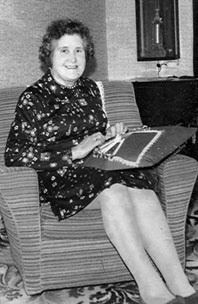
Dorothy – Lace making – 1982
In many ways Dorothy was really clever. After leaving school, she was a cook when she lived in with Mrs and Miss York, at the house on the right of Barclay’s Bank in the High Street. She stayed there until the week before we married. After school she stayed behind and was taught by Miss Ellen Whitmee to make pillow lace. Subsequently she has taught many people the skill, including our son’s wife Veronica who now has classes at her home down in Essex. I am sure that this would have pleased Dorothy. Dorothy and I were married for 57 happy years. When she was 80 years old she had a severe stroke and died. Thinking back, what a blessing she didn’t lay and suffer. As I am writing today, April 23rd, would have been our 65th wedding anniversary.
Did you know Dorothy’s Dad was from Cottesbrook? He, and several of the Tee family, worked on the Althorpe estate, which belonged to Earl Spencer (the late Princess Diana’s grandfather). Her Dad was second horseman to the Earl, and was always with him when he went hunting. When the Earl went out in his coach, he used to ride on a hunter beside the door, as escort. The head groom drove the two horses and two footmen sat at the back.
Dorothy’s dad left the service of the Earl and volunteered for the army fighting the Boers in South Africa. When he came back to England he went to work at Perkin’s Nurseries in Northampton. Whilst he was there, Perkin’s had the job of landscaping Mr J W Mann’s garden at Olney, and as it was going to be rather a long job, he enquired about getting lodgings in Olney. Someone told him that Martha Jane Peters could perhaps help him. Her husband, Arthur, had died, leaving her with two boys and two girls to bring up and she would be glad of the extra money. So he moved in and as the garden work took some time, and they got on so well together, they married, and later had a son, Len, and a daughter, Dorothy (my wife). This is how Dorothy’s Dad came to live in Olney.
Now we are going right back to the time before the coming of the railway through Olney. Our High Street ended at Town Farm, now Mr Ivor Pibworth’s. On the opposite side it finished at the ‘Kitchener’s farmstead cottage’ next to Brocks Garage. Down alongside the farmstead was ‘Old ‘s Lane’ where one had to go to get to Hatch Green Farm.
Note: If Percy is correct, then the lane currently signed as ‘Holes Lane’ should be ‘Old’s Lane’.
Click a map image to reveal a larger and clearer picture
This farm was owned, or perhaps rented, by Mr Old. There was a pathway (now Newton Street) that ran through the farm. It continued across what is now Midland Road. The path continued on the other side of Midland Road (note: as it does today) alongside the modern bungalow towards the railway embankment. Steps were put in the embankment to cross over the railway lines and the footpath continued across the field to Lavendon Road. This path was there many years before the railway was built in 1872.
Note: The total length of this footpath (coloured green) can be traced on the 1882 map.
The plot of land on the north side of Old’s Lane was sold to the Freeman family. They built Beauchamp Terrace in Dartmouth Road and Warwick Terrace in East Street, which stand back-to-back. The houses were built with local stone maybe from the stone quarry opposite the entrance lane leading to Lavendon Grange. Most of Olney houses were built of this stone and possibly our 700 years old Church.
The plot next to Freemans in Dartmouth Road was bought by John Walker Smith who built ‘Maple House’ in brick. In the garden were his hay and straw barns, and over his kitchen he built a little factory, where one or two women did shoe work. His daughter Martha Jane (note: who was first married to Arthur Peters, see above) lived in the fair sized cottage built at the bottom of the garden. This faced Jonathan’s Lane, as it was then called, but now forms the northern end of East Street. Then he bought another plot of land across the other side of the lane facing this cottage and built a house on this plot for one of his sons, Stanley Smith. In the garden were stables, cow sheds and a cart shed with upstairs rooms for storing cattle food.
His other son Herbert married Matha Cowley, daughter of Sam Cowley. (Sam later owned the shoe factory in Yardley Road, almost opposite the Castle Inn.) Another daughter married Jim Drage, who worked at Northampton Brewery. They lived next door to Joe Garner’s shop and private house. Another daughter married Charles Dimmock. They had a shop on the Market Place selling cycles, prams and the like, and lived in the High Street in what became our old ‘Co-op’.
John Walker Smith’s wheat fields were at the back of the Yardley Road School. In a field near Yardley Road there was an old railway carriage which was used during harvest time for teas with the grandchildren when they came gleaning. His meadow fields were those by the old bathing place and extended along to the railway.
The poultry farm and large orchard in East Street belonged to John Walker Smith and were between the recreation field gates and the old thatched cottage. He also had the tiny cottage on the edge of East Street where he always stored his apples.
Later, the plots from Maple House to Dartmouth House in Dartmouth Road were sold for building. The Queen Hotel was built at the same time as Olney Station, next door to a thatched cottage. (Note: This cottage is no longer thatched.)
Can you imagine that when the railway was completed, the land where the old Hinde and Mann’s shoe factory now stands was all fields? There was no Wellingborough Road, Midland Road, Newton Street, Cowper Street, or the north end of East Street. A rough road was made across the fields for people to get to and from the Railway Station and was known as Station Road. Later, it was properly surfaced and became Midland Road after the railway company.
When the train was due, people could leave their pony carts at the Queen Hotel. Also people coming to stay in Olney could put up at the ‘Queen’. My great-grandfather and his son from Turvey worked on the building of the railway. I was told that, when building the embankments, several horses and men were killed by the carts tipping over, and two or three men who died were buried at Turvey. No one knew who they were, or where they came from.
It is said that, in 1872, the first train arrived at the station with a few people riding in the engine, which was decorated with flags. All down one side of Olney High Street there was a fair with plenty of stalls. The public houses opened at 6 am and as the train waited at Olney Station for some time, every one had plenty of time to have a drink! My Olney Grandfather Wright had been helping out at Olney Brewery, so he was given the honoured job of putting a barrel of Hipwell’s Famous Beer on this first train to Northampton.
Now when the streets near the station were being built in the 1890’s, a small workshop was put up at the rear of each house, as most of the people who moved in were shoemakers. Often, each person only made part of the shoe. Shoes were then passed to someone else to do his part of the shoe, and so it went on from one to the other. When the shoes were completed they were taken to Mr William Hinde’s building at the rear of Minney’s High Street shop (note: opposite the Fire Station). There, girls cleaned them and boxed them, ready to be sent to the customers’ shops.
Mr J W Mann bought two houses in the High Street and altered them into one big house. He named it ‘Orchard House’ because he bought part of the back gardens of several adjoining houses and landscaped them into one large garden with an orchard. Even the iron railings along the front of this house were made to represent trees growing in the orchard. When the house was complete, Mr Mann moved in from No 31 Midland Road. Not long after this he went in partnership with Mr William Hinde, and they built a small factory on the comer of Dartmouth Road and Midland Road, where the large building now stands.
The small workshop shoemakers all had a tradition, which was that ‘no one worked on the first Monday of each month, because this was St Crispin’s Day, who was the patron saint of Shoemakers’. They went to the public houses which opened at 6 am to drink his health, and of course, drank more than was good for them, and also spent too much money. So on the Tuesday they had to work harder and faster to try and catch up with their work. Often the shoemakers’ wives had to help their husbands, but later, the wives were offered jobs in the factory which they accepted. The small factory had to be very much enlarged; machines were installed. In time, the big orders came in, and at its ‘peak’ the factory employed 364 workers. Later, Hinde and Mann bought Fullers bakery shop and house next door in Midland Road to be used as offices. The women seemed happier all working under one roof. It must have pleased them that the tradition of St Crispin had to be forgotten!!
Note: Percy also wrote about the mutual ties of Pam’s and his wife’s family and their links to the town’s three major shoe factory owners. The ties are illustrated in the family tree below.
I hope some of these old times are of interest to you, Pam. Thank you for listening to me.
Percy Wright
Second letter – A letter to my friend, Les Fairey
This letter to Les Fairey was undated but possibly written around 1995. Les was a very well known and popular man in the town who owned and managed ‘Allens of Olney’ for several decades. He served on the Rural District Council and for many years was Chairman of the Parish Council and President of Olney Rugby Club. The letter has been truncated to avoid excessive repetition with the other two letters.
Dear Les
When we met the other day, we talked about the history of Olney, and also about the people who lived here, and how it has changed even in our lifetime. So shall we begin by thinking about our Churches? Tradition tells us that Olney’s first Church was situated at the north end of the town somewhere near the Castle Inn. When we were school children, we always knew Moores Hill as ‘White Cross Hill’ because the school at the top of this hill stood opposite where once was placed a large white cross. History has it that the land from this cross down to the Castle Inn belonged to the Church, and the former Colson’s farm buildings and the Feoffee Cottages probably stand on the site of the Churchyard. The water supplying the Yardley Road horse trough was possibly from a stream running beside the church. When the foundations and drains for the Feoffee Cottages were being dug out, many human bones were found. They were re-buried in the Churchyard of St Peter and St Paul, at the other end of Olney.
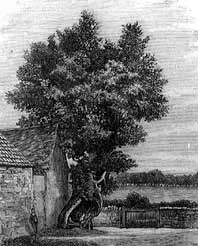
Churchyard Elm
Do you remember that there was a hollow elm tree at the bottom of Hopper’s Hill opposite ‘The Queen’ in Dartmouth Road? This tree was reputed to be growing in the corner of an earlier churchyard. Being hollow, us boys enjoyed climbing to the top from the inside. Once, the Council had a large heap of road-repairing materials just near the tree, so we used to jump on to it from the top of the tree. This tree must have been a great age when it partially fell down in 1935. Later, a seat was put there for people to rest while waiting for a bus, and afterwards a stone shelter was built with a seat inside it, so people could shelter from the rain.
Bert Davis of Lavendon started a bus service and then later, the Eastern National Bus Company bought him out and ran a service from Bedford to Stony Stratford. They also ran a service from Northampton to Bedford. The United Counties Bus Company ran a service from Olney to Wellingborough. We had a good railway service from Northampton to Bedford, but as the railway station was at the bottom of Midland Road, the buses attracted more customers. It was a long walk from the other end of the town to the station.
I am now thinking back in time to my Mother’s father, a Turvey man. He left working for Squire Higgins (who ‘bought’ Turvey Village) and worked on the building of the 24 miles long railway from Bedford to Northampton.
The Squire of Turvey wouldn’t have a railway station built in the village, but as far out as possible. No trains were to run on Sundays. The railway company agreed these terms and used the land along the Bedford and Bucks border. There was also a load of trouble siting the railway station in Olney. The railway company wanted the station sited in the High Street, but that would have meant having a level crossing where Orchard House stands. The line would have carried on through the garden of the house, across West Street, up Long Lane and then would have formed a straight line to Piddington, before proceeding on to Northampton. Obviously this plan was never carried through.
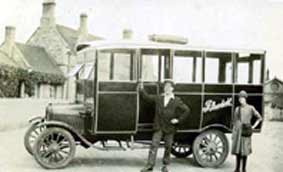
‘Bob’ Wesley and bus outside Olney Station
The railway line was opened in 1872. My Grandfather Wright, who helped with the delivery of Olney Brewery beer to the station, was told by Mr Hipwell, the owner of the brewery, to put a barrel of their best beer on the first train to Northampton. It would make a good advert for the Olney Brewery. During this particular week a Fair was set up on Olney’s High Street. The public houses opened early each day, and because each train waited in the station for some time, the passengers could go and enjoy an ‘opening celebration drink’. The first train was full, and a few passengers were allowed to ride on the engine. In 1962 I went to the Station to see the last passengers travel the line, but what a dismal sight that was; the railway line closed after ninety years.
Let us move on and have a look at our church, St Peter and St Pauls. One day the top of the spire was struck by lightning and a line can still be seen today where it was rebuilt. The steeplejacks recovered the cockerel weather-vane and took it to Fred Morgan’s workshop, for cleaning and re-gilding. (Sidney Morgan lived there in our day). My father was working for Fred at the time, and as they were cleaning the cockerel they found a fairly large bullet hole. Together, they wrote their names on a sheet of parchment and pushed it inside the bird for others to find it. Dad told me that on the weather vane were the words ‘I do not crow, but I stand to show’, whence winds do blow’.
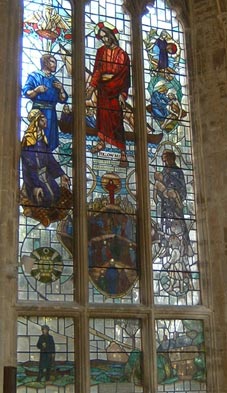
Leper’s Window –
St Peter & St Paul’s Church (2006)
The church has some very nice stained glass windows. An unusual one is in the Chancel, beside the Pulpit. At one time, the bottom part of the window was clear glass so that people who had leprosy, and were not allowed in church for fear of infection, could stand outside and watch the Service. This clear glass has now been replaced, showing the Reverend Langley standing in a garden.
It is still named the ‘Leper Window’. (Reverend Langley was Mrs Archie Allen’s father in No 15 High Street). Before we leave the Parish Church, we can see at the back, a pulpit which was used by John Newton when he was Minister at Olney. The church was built between the years 1320 and1330. Recently, the rear of the church has been altered for the first time in its existence. Mr Phil Cowley sponsored an upstairs room to be used for meetings. This is at the back of the large clock and the belfry, and is named the Cowley Room. Downstairs, a toilet has been installed, fitted with an extra wide door for wheelchair users.
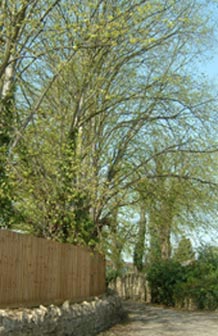
Lime Street (Spring 2006)
Gresham House garden is on right
When Weston Underwood churchyard was getting too full, permission to share Olney’s churchyard was given to the Parish. In those days coffins had to be wheeled to the graveside, so to shorten the long walk to Olney churchyard, a Magistrate’s Permit was obtained. This entitled the funeral party to use the narrow road from Weston Road, down to Bridge Street, and then to proceed through the church gate on Emberton Road. Arthur Hipwell lived in ‘Gresham House’ (later known as ‘Bay House Nursing Home’) situated on the corner of this road which became known as ‘Dead Lane’. He didn’t like this name so he set fast growing lime trees in his garden to hang over his wall and then had the lane re-named ‘Lime Street’. Straight opposite the entrance to this lane in Weston Road, was one of Olney’s many public houses, named ‘The Star’. It subsequently became a shop owned by the Shouler family.
Did you know that Olney once had an Abbey, the home of the Olney Monks? The entrance to the Abbey was probably to the left of Allen’s Drapery where the archway now stands. In Spring Lane there is a pond with bushes growing around it, and this may have been one of the Abbey fish ponds, to provide the monks with food.
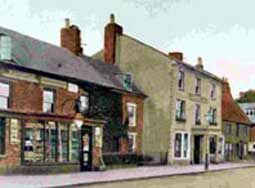
Ann Hopkins Smith residence
There is another shop to the right of the draper’s shop, and next to the Bull Hotel, where at one time lived Miss Ann Hopkins Smith. She was a Quaker, and she had the Olney Almshouses built in Weston Road, homes for spinsters and widows. Later, she had a school built to the left of the almshouses, free for children if their parents couldn’t afford to pay for their schooling. This property was later named ‘The British School’. At one time a stage was built, and it was used for concerts and all kinds of meetings.
My grandfather, George Wright, lived at No 38 Weston Road, opposite the British School, He was always known as Dickey Wright, as his father was named Richard. He was the local bill-poster for all the villages around. He had a horse called Tommy and a smart four-wheeled cart to travel round in. The cart carried his ladder, needed to reach his display boards, a pair of steps, and his small barrel of paste. Every two weeks he went round all the pubs to put up a Bill of Sale (or to notify a Special Meeting, or a Garden Party) in their windows for everyone to see. One day the Vicar of Olney borrowed Tommy and the cart, to take his wife to visit her friends. When he took Tommy back, he wasn’t very pleased. He said “George, I think you ought to change your ways, because as we came to each public house, Tommy turned into the back yard and waited, so I had to get out and lead him back onto the road. George, do you understand, it was at every public house all round the district. What would the Olney churchgoers say, or do to me, if they saw me?” After this, he didn’t borrow Tommy again. Of course, he did not realise that the route taken by George when delivering his posters, was well known to Tommy without needing to be told!
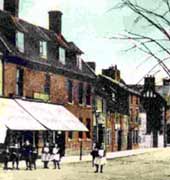
Garners and a cycle post
Now back to our school days. When we knew that some of us would be leaving school at Christmas, we asked each other if anyone had a job to start in the New Year. I remember Sidney Field saying that he had applied for the job of shop boy at J Garners on the Market Place. His first job every morning would be to place the cycle posts in holes at the kerb of the pavement so customers could lean their cycles against them while they were in the shop. Now one Sunday, as my Mother and Dad were walking up to church, Dad said, “Oh look, my bike is standing outside Garner’s shop. I came up on Saturday to buy a new tie and I forgot the bike. Oh well! I will take it home when we come out of church”.
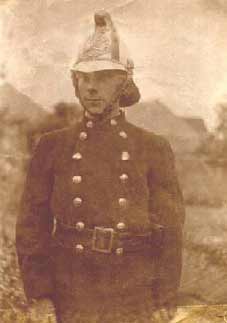
Fireman Percy in brass helmet
Do you remember how, in Olney, the first Sunday in May was always known as Hospital Sunday? We had a procession headed by the Olney Band, followed by our Parish Councillors, then the St John Ambulance men and nurses; then came our Fire Brigade, who on this day, always wore their shiny brass helmets. They were followed by the different clubs such as the Odd Fellows, Free Gardeners and the Order of Buffaloes, all of them wearing their ceremonial regalia. Next came the scouts, girl guides, the brownies and cubs, all going to Olney Church for a special Service. The Chapel Minister always took part in this Service. People lined the High Street to watch the procession go by, and to put money in the collectors’ boxes in aid of Northampton Hospital. Although, at that time, the Church seated several hundred people, this was the day when the Church doors were left open for the over-spill to stand in the porch and Churchyard and listen to the Service. This day was always a special day, when children who were living away came home; all enjoyed a lovely family tea, before saying “Goodbye; we will see you next Hospital Sunday”.
Les, I suspect that you remember most of these old times at least as well as I do. Thank you, my friend, for listening to me.
Percy Wright
Third letter – A letter to Brian Marshall
In this letter to Brian Marshall written in 1993, Percy relates tales of local characters and some of his reminiscences of being in the Home Guard during World War II. He and Brian’s father, George, were the best of mates.
Dear Brian
After seeing you, I went home to Clifton court and I sat and thought about your father, George, and your family all those years ago.
As you know, we lived at 12 Midland Road, at the time when your mother’s sisters and brothers lived at No.6, so in a way, we were brought up together. Your grandfather was Herbert Wooding, and my father was Herbert Wright. As years went by I was often called Young Herby. My grandfather Wright lived at No 38 Weston Road. His name was George, but as his father was named Richard, he was generally referred to as Dickey Wright. My school name, among the boys, was Wrightey, but if they wanted to quarrel or have a fight, they started calling me Dickey. I can remember your mother’s sisters. Nancy married Tom Wilson, who later on became a Baptist Minister. Nellie, the taller one, worked in a shoe factory. I’m not sure where Amy worked, but I believe she married a fellow from one of the villages around. Your mother, Elizabeth, worked at the International Stores, which was next door to Barclay’s Bank. I seem to remember her brother Fred, coming home on leave during the 1914 -1918 War and brother Harry, who also for a time worked in one of the factories.

Olney Midland Road c1900
Do you remember Teddy Dix living at No 8? He was traveller for Bells the Ironmongers in Northampton. Also, do you remember his brother, Arthur Dix, the shoe maker and repairer, who lived opposite No 8? Teddy Dix’s mail often got mixed up with his brother’s so Teddy decided to move out of Midland Road. He bought a building plot at the top of Weston Hill, on the right hand side and had a house built. He named it ‘Weston Way’ and changed the spelling of his name to ‘Dicks’, so this put things right for the postman. A little later however, a man who came from Northampton bought the building plot next door. His name was also ‘Dicks’, so with all this changing, Teddy was back to square one.
Talking about Weston Hill, did you know that I was born in the cottage near to the beech tree? At this time it just stood there alone, and all around was a wheat field. My mother was washing up, and some pieces of food were sticking to the plates, so she pushed them off, over the stone wall for the birds. When she was drying her hands, she realised her wedding ring had gone. Both Dad and Mother searched around the garden, even felt inside the drain, but no ring was found. The wheat, growing all round the house was short and green, but during autumn, Dad spotted something shining in the wheat, so going very carefully, he found the ring caught up on an ear of wheat. I was only about two years old, but I can imagine the excitement when after all those months the ring was found.
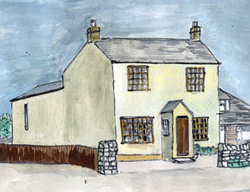
Sketch of Yew Tree Cottage (2006)
Weston Road seems to be part of my life. My grandfather lived at No 38 for over 60 years. The house on the hill was my parents first home, and when we were talking about getting married, Mrs Wilford, who lived two doors from our High Street Doctors, asked us would we like one of her cottages in Weston Road, as she owned the four houses at the bottom of Weston Road including the house where Mr and Mrs Brundle lived. This was our first home together. Our eldest son John was born in this house. I said to Dorothy that I would like to take him out in the pram on my own first, so all was made ready for the proud new dad. Mrs Talbot lived In the large house across the road (near our new Co-op). She was out for a walk with her sister, Miss May Hipwell. They came across the road and said “May we just have a peep of the very young Weston Road-born baby”. This they did and Mrs Talbot said “Isn’t it marvellous, a child so small can grow into a large strong man”. Miss Hipwell patted me on the back and said “Yes, but how nice to see his elder brother taking him out in the pram”. After this, I decided I had better grow a moustache and I’ve always had one, although almost 85 years old.
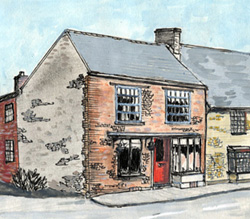
Sketch of The Star pub? (2006)
then ‘Dreams’ shop
My Dad told me that years ago, the shop on the right hand side of Weston Road, just before reaching the British School, had been the Star public house. (Much later it became John Kent’s grandparents sweet shop.) I have been down in the cellar which is under the shop floor. Strangely enough, there was a fireplace and also standings for the beer barrels. To make things easier for the landlord, a beer pump was fitted saving him going up and down the stairs to draw the beer. When these alterations in the cellar were taking place, a plumber fitted the copper pipes to the pumps whilst a bricklayer built the supports for the standings. The bricklayer came up and said “I am so hot down there; I can do with a drink to cool me”. The plumber said “In my bag is a bottle of lemonade”. The bricklayer then went to the plumber’s tool bag, instead of going to his lunch bag which contained the lemonade and biscuits. The bricklayer goes and has a good mouthful but unfortunately he swallowed Spirits of Salts, which plumbers use for cleaning the copper pipes in readiness for soldering. Sorry to say, he didn’t live very long after this. The bricklayer was Jack Adam’s father, who also lived in Weston Road.
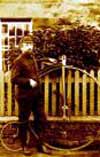
Penny farthing cycle
Mr Pater from Weston Underwood hired out steam thrashing engines and very large steam ploughing engines to farmers. These were kept at the back of the building, now named ‘Bucks Lace Industry’ where Harry Armstrong had a team of ladies sewing pillow lace on handkerchiefs and tablecloths. Mr Pater bought a penny farthing bike and soon he was able to ride it round Weston village. Later, when he was more courageous, he rode it down to Olney. He was just coming down Weston Road in fine style, when Susannah Watson’s milking cows were being taken to the back of the Sun Inn for milking. He ran into the back of them, and of course he fell off among them, and you know what cows do, even walking along, so my grandfather helped him up onto his feet, leaned the bike against the wall and washed him down at his yard pump. Then grandfather took him into his house and gave him one or two glasses of grandma’s strong homemade wine whilst he sat comfortably in front of a good fire. After a while Mr Pater decided he wouldn’t ride the bike again, so grandfather put it away safely in one of his sheds, and took him back home to Weston Underwood in his pony cart. About three years later I was given this bike. I used to climb up lamp posts to get on, the front wheel was 5ft 6ins across, but perhaps you may remember seeing me riding on what I nicknamed ‘Goliath’. One day, an open-topped bus stopped to pick up passengers near the Queen Hotel and as I rode past, I shook hands with those upstairs.
I started at school in Olney High Street before I was five years old. All the boys were separated from the girls until Bucks County Council decided to have boys and girls mixed together when I was about 13 years old. The day came, and in came the girls. Teacher said to them “You sit here, and you sit there”. The one who was put next to me eventually became my wife and we had 57 happy years together.
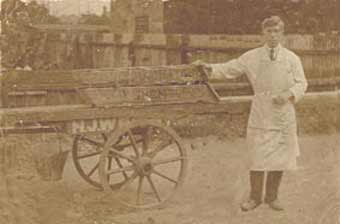
Percy as ‘House Decorator’
As you know I was a house decorator, learning the trade from my dad. We had an apprentice named Frank Boswell, who lived, until he married, in one of the houses adjoining the almshouses. After Frank finished his five year term, he worked in Northampton with his cousin, Ray Perkins, who was in charge of decorating all Phipps’s public houses. Frank was also friendly with Bobby Soul and had the occasional job of being a coach driver for several years. One day someone was taken ill on the coach and was very sick. Frank had the nasty job of cleaning it up. Sadly, the sick person had polio, and sorry to say, Frank also caught polio and died, leaving his wife and two children living in a new house in Olney Road, Emberton.
Time marches on, they say Brian, and your dad was put in the Home Guard, and so was I. We did plenty of training. Our headquarters were in the Old Brewery at the back of the Bull Hotel. We had lessons about gas and the use of gasmasks. We trotted round all the fields in the pitch dark. We ran up and down Long Lane and round Hungary Hall Farm so many times that we began to feel like rabbits. Next, we were kept busy on the miniature rifle range inside the building. Some years previously I had had an accident and lost the sight in my left eye. Unlikely as it seems, this made me into a crack shot, both on the miniature, and the rifle range up at Hyde Farm. What I enjoyed most of all was firing under Army battalion rules on the range at Princes Risborough. It didn’t matter at what distance the targets were put up, I could hit them. Some of the other Home Guards from Bucks disputed that I even hit the targets, so an army sergeant gave me some incendiary bullets and I hit the target and set it alight ten times out of ten. At Olney Fair, because of this skill, I used to win cups and saucers, plates and dishes and other porcelain ornaments.
Anyway, we were then put in the Mobile Squad, and when the invasion went over on D-Day, hundreds of us Home Guards were taken by army convoy down to the coast. There were so many Home Guards, then soldiers, then another lot of Home guards, then Marines in the convoy. Our troop landed up on the mouth of the River Blackwater near Bradwell Aerodrome. There were no buildings; the nearest village named Steeple was two miles inland. George Marshall, Sid Ward, Peter Rose from Newport Pagnell, and I were always together. The marines were camped next to us and most nights we heard them, but couldn’t see them, as they went on sea patrol in the pitch dark. Our job was guarding the sea wall, walking along the top of it. First time out, we lost Sid Ward, who fell off into the sea, and when we eventually found him, a Marine sentry had got him, and we had to get Lieutenant Reg Whinnett to identify him, before they would release him.
Although we were on patrol every night, we were taken out to sea by the Marines and put on an island with them, climbing rope ladders, crawling under rope netting spread over the beach. There was a building where everything was booby trapped, using loud flashing fireworks representing grenades etc, just as a building would be left for the enemy to take over. The landing craft was supposed to be damaged, so the ramp wouldn’t open and we had to wade to the craft and somehow get inside it. Some of us used very bad language, getting soaked, but it made a change from running around Hungary Hall!
One night at 3.30 in the morning we heard a squeaking noise and listening to it, we four decided it was someone riding a bike. It could be trouble, so two of us stood one side of the road, and two on the other side, and as it came between us, we pushed our rifles to where we thought the wheels were. This did the trick. There was a grunt and some English swearing as we grabbed hold of whoever it was, and not very carefully I might say. We pushed him into one of our sheds where there was a small lamp. It turned out to be a cook off Bradwell Aerodrome who had turned the wrong way in the dark. If we hadn’t stopped him, he would have fallen into the Marines landing bay. I bet he called us Home Guards something unprintable, without even saying “Thank you for saving me from a good soaking”. These are just a few little things that happened before we were brought back home, and it was nice, in a way, to hear our workmates saying “Welcome back”.
We had a big laugh on one Sunday morning, outside the Old Brewery. Our Sergeant had formed us up in a square, ready, because Sir Duncan Everard, one of the HG’s ‘brass hats’ was coming to inspect us. Just before Sir Duncan arrived in strutted Captain A G Morgan. When he got to the centre of the parade, he fell over on his stomach, then rolled over on his back. The straps of his gaiters had become hooked together, because he had put them on the wrong legs. We only managed to get him up and change his gaiters over as Sir Duncan arrived. I wonder what he would have said had he arrived ten minutes earlier!
In one way I was sorry I had to hand in my accurate rifle, but I still have my cap badge. I like to think back, remembering what faithful mates we four were. Also how George and I were the best of friends even when many years later we worked together at Robert Maxwell’s.
Thank you for listening to me, Brian.
Percy Wright
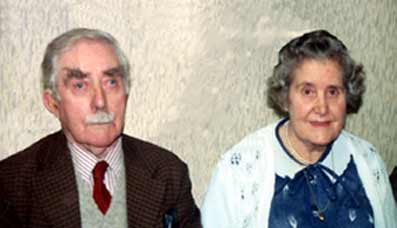
Percy & Dorothy – January 1989
Acknowledgements
The ODHS wish to thank the Wright family for permission to publish these letters, also the recipients Pam Morgan, Brian Marshall and the family of Les fairey for the loan of the letters to the Society. Thanks also to Ian Cox for the sketches of Yew Tree Cottage and The Star Pub.
.
Copyright © 2008 Olney & District Historical Society

